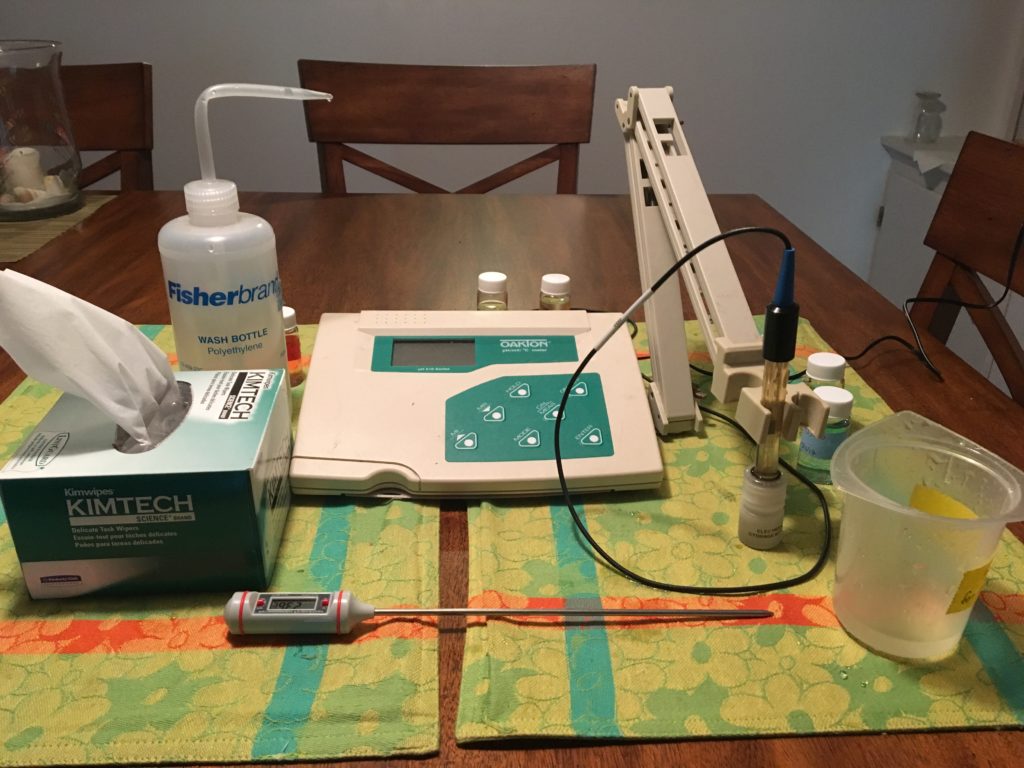Sometimes I bring work home with me…

Last Friday, I brought my pH meter home and set it up on my dining room table. Frankly, I felt pretty eccentric doing that. I wanted to find out if there is a measurable daily cycle in pH within the marsh tide pool I’ve been studying. A main reason to expect a daily pH cycle is that carbon dioxide acts like an acid within seawater. During the day, plants and algae use sunlight for photosynthesis – they take up carbon dioxide and produce oxygen. At night, because there is no light, the plants and algae stop taking up carbon dioxide. It builds up in the environment (creating more acidity and decreasing the pH) because all of the animals, plants, and many microorganisms keep respiring – they use stored energy (food) and produce carbon dioxide. The pH in marsh pool could be interesting because the pools are usually cut off from the ocean, so they can have very big changes in water chemistry during the day.
I’ve already measured big daily cycles in temperature and oxygen. Animals living in the tide pool during the summer have to cope with very warm days and stifling nights. Think you have a hard time sleeping on a stuffy summer night? Imagine the oxygen concentration dropping to nearly nothing! I’ve measured a smaller salinity cycle, and episodic changes in water level with very high tides. But I still wanted to know about the pH. I don’t have a continuous sensor, so the only way to do it was by strolling out there and collecting samples. And since my house is pretty close to the marsh, it was easiest to set up the pH meter at home.
I sampled at 5 times over a day: 5:48 pm, 9:35 pm, 5:20 am, 11:51 am and 3:20 pm. It was pretty fun! I wanted to get out later at night, but I was honestly a little nervous about doing it alone. I talked a good friend into escorting me for the 9:35 pm sample, but wasn’t able to get anything later. The 5:20 am sample was memorable because it seemed unbelievably early to me, but as I was driving over, I spotted one of my “early bird” running buddies out on the sidewalk already getting in his miles. It was surprising how many people were already out and about. And at 11:51, a couple friends riding by on their bicycles spotted me on the edge of the tidepool. Luckily they like science and didn’t think it was too weird of a way to spend a Saturday.
So what was the answer? Honestly I don’t really know yet, but I’ve learned enough to want to study this further. I measured the lowest pH at 9:35 pm, but I assume it kept dropping. By 5:20 am, it had already risen a bit. It doesn’t seem to me like that would be due to photosynthesis (sun hadn’t risen yet), so my best guess is that the tide came in and brought an influx of seawater. I’ll check the data I have against tidal records, but I really need to get some measurements later at night. I’m hoping to borrow a pH logger soon that would automatically record measurements over the course of the whole 24-hour cycle. As is, I saw a pretty big range, about 0.6 pH units between 9 pm and 3 pm.
I’m hoping this work will help me better understand the adaptations of animals I study in the lab. I perform lots of experiments with a sea anemone (Nematostella) that naturally occurs in this radically fluctuating marsh habitat. We have some pretty interesting experiments planned over the next several months to explore how Nematostella responds to all this variability.